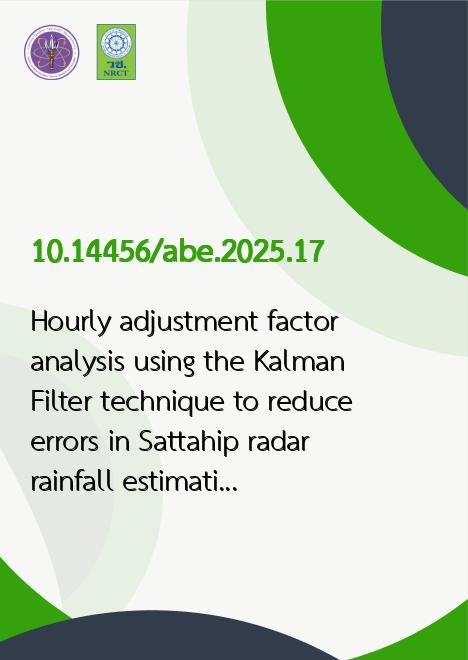
|
Hourly adjustment factor analysis using the Kalman Filter technique to reduce errors in Sattahip radar rainfall estimation |
|---|---|
| รหัสดีโอไอ | |
| Creator | Ratchawatch Hanchoowong |
| Title | Hourly adjustment factor analysis using the Kalman Filter technique to reduce errors in Sattahip radar rainfall estimation |
| Contributor | Siwa Kaewplang |
| Publisher | Faculty of Engineering, Khon Kaen University |
| Publication Year | 2568 |
| Journal Title | Agricultural and Biological Engineering |
| Journal Vol. | 2 |
| Journal No. | 4 |
| Page no. | 117-126 |
| Keyword | Weather radar, Automatic rain gauge, Rainfall event, Hourly adjustment factor |
| URL Website | https://ph04.tci-thaijo.org/index.php/abe |
| Website title | ThaiJo |
| ISSN | 3056-932X (Online) |
| Abstract | Weather radar can continuously measure rainfall immediately as it occurs, covering wide areas and providing high-resolution rainfall both spatially and temporally. However, in radar rainfall estimation, even when using Z-R relationships that vary according to rainfall clusters based on rainfall intensity measured from ground-based automatic rain gauges to reduce estimation errors, there remain discrepancies in adjusting radar rainfall measurements above ground to match actual ground rainfall. Additionally, each rainfall event has different raindrop distribution characteristics, resulting in varying physical characteristics across different rainfall events. This study collected data from 510 rainfall events between February 2, 2018, and August 31, 2020, comprising hourly rainfall from 110 automatic rain gauges and radar reflectivity within a 240 km radius of the Sattahip radar. The aim was to analyze rainfall estimation methods using Z-R relationships that vary by rainfall cluster according to rainfall intensity, combined with appropriate hourly adjustment factors for the Sattahip radar. The study found that the rainfall estimation method using Z-R relationships that vary by rainfall cluster according to rainfall intensity, combined with hourly adjustment factors analyzed using the Kalman Filter technique, most effectively reduced the errors in adjusting radar rainfall above ground to match ground rainfall. Considering the RMSE values, the method can reduce the rainfall estimation error by 21.53%, 4.10% (21.87%,5.19%). Based on the MSE values, it can reduce the estimation error by 47.71%, 8.37% (48.50%, 10.63%). Similarly, based on the MAE values, it can reduce the estimation error by 29.05%, 4.55% (31.32%, 6.28%) for the rainfall events used for calibration (Verification), compared to the rainfall estimation methods based on the current Z-R relationship, and the Z-R relationship that varies according to rainfall type and intensity without adjustment. |